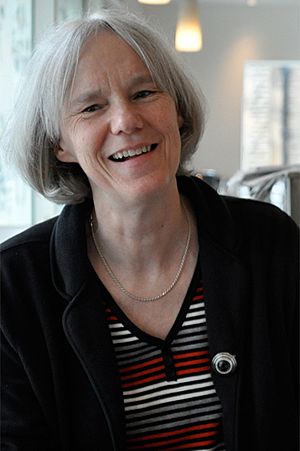Elizabeth Robertson facts for kids
Quick facts for kids
Liz Robertson
|
|
|---|---|
 |
|
| Born |
Elizabeth Jane Robertson
|
| Alma mater | University of Oxford (BA, MA) University of Cambridge (PhD) |
| Awards | Royal Medal (2016) EMBO Member (2002) Suffrage Science award (2011) |
| Scientific career | |
| Institutions | Columbia University Harvard University University of Oxford |
| Doctoral advisor | Martin Evans |
Elizabeth Jane Robertson is a famous British scientist who studies how living things grow and develop. She is a professor at the University of Oxford and a top research fellow.
She is best known for her amazing work with mice. She discovered a way to change the genes in mouse embryos using special cells called embryonic stem cells. This breakthrough helped scientists all over the world understand how genes work and what happens when they are changed. Her work has been very important for both biology and medicine.
Contents
Education and Early Career
Elizabeth Robertson studied at the famous University of Oxford and later earned her PhD from the University of Cambridge in 1982. A PhD is one of the highest degrees a person can get in a subject.
After finishing her studies, she worked as a researcher at Cambridge. She then became a professor in the United States, teaching at Columbia University and Harvard University. Eventually, she returned to the UK to continue her work at the University of Oxford.
Groundbreaking Scientific Discoveries
Professor Robertson's research has changed how we understand life itself. Her work focuses on developmental biology, which is the study of how animals grow from a single cell into a whole creature.
Changing Genes in Mice
Her most famous discovery was figuring out how to use embryonic stem cells to make specific changes to the genes of a mouse. These special cells can grow into any part of the body.
By changing a gene in these cells, she could create a mouse with that specific genetic change. This allowed the new gene to be passed down to the mouse's babies. This technique, called "gene targeting," gave scientists a powerful new tool. They could now study what each gene does by "turning it off" or changing it and seeing the effects.
How the Body Takes Shape
Robertson also made important discoveries about how an embryo develops its shape. She studied how an embryo knows which end will be the head and which will be the tail. This is called anterior-posterior polarity.
She also researched how an embryo develops a left and a right side. For example, she helped uncover the secrets of why your heart is on the left side of your body and not the right. Her work has helped explain the basic rules that build a body from the very beginning.
Awards and Recognition
Professor Robertson's incredible work has earned her many awards. These honors show how important her discoveries have been to science.
In 2024, she was appointed a Commander of the Order of the British Empire (CBE) for her contributions to medical science.
Here are some of her other major awards:
- Royal Medal (2016): She received this for her amazing work on how mouse embryos develop.
- Fellow of the Royal Society (since 2003): This is one of the highest honors for a scientist in the UK.
- Edwin G. Conklin Medal (2008): An award from the Society for Developmental Biology for her research.
- Pearl Meister Greengard Prize (2007): A top prize for women in biomedical research.
- Waddington Medal (2009): The most important award from the British Society for Developmental Biology.
She has also served as an editor for important science journals like Development and Developmental Biology, helping to share new scientific knowledge with the world.

